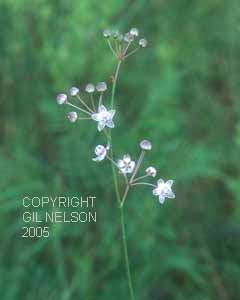Asclepias cinerea
| Asclepias cinerea | |
|---|---|

| |
| photo by Gil Nelson | |
| Scientific classification | |
| Kingdom: | Plantae |
| Division: | Magnoliophyta - Flowering plants |
| Class: | Magnoliopsida - Dicotyledons |
| Order: | Gentianales |
| Family: | Asclepiadaceae |
| Genus: | Asclepias |
| Species: | A. cinerea |
| Binomial name | |
| Asclepias cinerea Walter | |

| |
| Natural range of Asclepias cinerea from USDA NRCS Plants Database. | |
Common names: Carolina Milkweed
Contents
Taxonomic notes
Description
In general, with the Asclepias genus, they are perennial herbs usually milky sap. The stems are erect, spreading or decumbent and usually are simple and often solitary. The leaves are opposite to subopposite, are sometimes whorled, and rarely alternate. The corolla lobes are reflexed and are rarely erect or spreading. The filaments are elaborate into five hood forming a corona around the gynosteguim. The corona horns are present in most species[1].
Specifically, for Asclepias cinera, the stems are simple, slender and solitary; they grow up to 3-7 dm tall; and are puberulent in the lines below the nodes. The leaves are opposite, liner and 5-9 cm long to 1-2 mm wide, and are glabrous. The umbels are 1-4 terminal or axillary from upper nodes, 2-3.5 cm broad, and are usually less than 8-flowered. The corolla is lavender in color, the lobes are 5-7 mm long, the corona is 4-5 mm in diameter’ the lateral hood margins are conspicuous with the acuminate tooth extending beyond the truncate hood apex. The horn is about the same size, equaling the body of the hood. The follicles are smooth, 10-12 cm long, 5-10 mm broad, are erect on the erect pedicels. Flowers from June to July[1].
Distribution
This species is found in southeast North Carolina, and south to Florida[2].
Ecology
Habitat
Asclepias cinerea is found in pine savannas (Weakley 2015) and sandhills, flatwoods, and bogs (Wunderlin and Hansen 2011). Specifically, it appears in longleaf pine-turkey oak woods, pine-palmetto woods, wiregrass savannas, scrub oak barrens, scrub at the edge of slash pine flatwoods, seepage slopes, and boggy savannas (FSU Herbarium). It can also be found in disturbed areas, including sandy clearings along power line corridors, ditches, and disturbed flatwoods (FSU Herbarium). This species occurs in a range of light levels, from shady to full sun, and in a variety of sandy soil types, including wet or dry loamy sand, boggy or gravelly soils, moist sand, sandy peat, and Penney (Typic Quartzipsamments) and Ridgewood (Aquic Quartzipsamments) soils (FSU Herbarium).
Associated species:Baptisia simplicifolia, Callisia, Chrysopsis, Crotalaria rotundifolia, Sisyrinchium, Stipullicida, Euphorbia telephioides, Cyperus filiculmis, Sophronanthe hispida, Tragia urens, Pinus palustris, Quercus laevis, and Aristida stricta (FSU Herbarium).
Phenology
This species flowers from spring to summer (Wunderlin and Hansen 2011). Specifically, in Florida, flowering has been observed from May to August(FSU Herbarium) and fruiting has been observed from June through August (FSU Herbarium).
Fire ecology
This species tolerates fire and has been found in recently burned longleaf pine communities, but the exact role fire plays in its life cycle is unknown (FSU Herbarium).
Conservation and Management
Cultivation and restoration
Photo Gallery
References and notes
Florida State University Robert K. Godfrey Herbarium database. URL: http://herbarium.bio.fsu.edu. Last accessed: June 2014. Collectors: L. C. Anderson, J. R. Burkhalter, A. F. Clewell, D. L. Fichtner, A. Gholson, R. K. Godfrey, R. Kral, R. Komarek, S. W. Leonard, M. Mayo, S. McDaniel J. B. Nelson, S. L. Orzell, P. L. Redfearn, W. D. Reese, A. Schmidt, C. R. Slaughter, and Jr. R. Wilson. States and Counties: Florida: Bay, Clay, Duval, Franklin, Gadsden, Gulf, Jackson, Leon, Levy, Liberty, Okaloosa, St. Johns, Taylor, Wakulla, Walton, and Washington. Georgia: Thomas.
Radford, Albert E., Harry E. Ahles, and C. Ritchie Bell. Manual of the Vascular Flora of the Carolinas. 1964, 1968. The University of North Carolina Press. 848-854. Print.
Weakley, Alan S. Flora of the Southern and Mid-Atlantic States: Working Draft of 21 May 2015. University of North Carolina Herbarium (NCU). PDF. 931.
Wunderlin, Richard P. and Bruce F. Hansen. Guide to the Vascular Plants of Florida. Third edition. 2011. University Press of Florida: Gainesville/Tallahassee/Tampa/Boca Raton/Pensacola/Orlando/Miami/Jacksonville/Ft. Myers. 270. Print.
- ↑ 1.0 1.1 Radford, Albert E., Harry E. Ahles, and C. Ritchie Bell. Manual of the Vascular Flora of the Carolinas. 1964, 1968. The University of North Carolina Press. 848-854. Print.
- ↑ Weakley, Alan S. Flora of the Southern and Mid-Atlantic States: Working Draft of 21 May 2015. University of North Carolina Herbarium (NCU). PDF. 931.